Welcome to binNotes | redThread™
Inspired stories about wine and taste makers.
By L.M. Archer, FWS | Bourgogne ML
The month of May ends with an abundance of Guest Wine Writer contributions.
For those of you who are unfamiliar, last year I started inviting some of my fellow wine writers here on binNotes | red Thread™ to shine a light on any rare, obscure, or under-appreciated wine region for which they feel a special passion.
It’s a great way to learn from industry experts and relish some fine wine writing in the process.
Enjoy!
❦
About Today’s Guest Wine Writer:
Michelle Williams | Rockin Red Blog
Rioja Alavesa: Going Its Own Way
by Michelle Williams
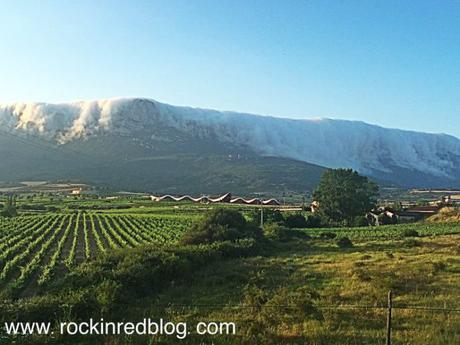
A wave of fog rolling over the mountains in Rioja Alavesa.
" data-orig-size="750,563" title="Rioja Alavesa Fog." data-image-title="Rioja Alavesa Fog." data-orig-file="https://binnotes.files.wordpress.com/2017/05/img_6690-e1494337949893.jpg" style="width: 696px; height: 522px;" itemprop="http://schema.org/image" height="522" width="696" data-medium-file="https://binnotes.files.wordpress.com/2017/05/img_6690-e1494337949893.jpg?w=300" data-original-height="522" alt="A wave of fog rolling over the mountains in Rioja Alavesa. | ©Michelle Williams - Rockin Red Blog." data-original-width="696" data-image-meta="{"aperture":"0","credit":"","camera":"","caption":"","created_timestamp":"0","copyright":"","focal_length":"0","iso":"0","shutter_speed":"0","title":"","orientation":"1"}" data-large-file="https://binnotes.files.wordpress.com/2017/05/img_6690-e1494337949893.jpg?w=700" /> A wave of fog rolling over the mountains in Rioja Alavesa. | ©Michelle Williams – Rockin Red Blog.Pablo and his sister Maria are the 5th generation of the Simón family to run their winery in Rioja Alavesa. Bodegas de la Marquesa Valserrano began in the 1880’s as a family winery and remains true to its roots today. In a region still utilizing traditional methods of hand-picking the grapes and employing mules to plow the vineyards, Pablo shares, “in the last decades there have been good technological advances and improvements in the means of wine producing, and as a consequence of that, nowadays even the humble small wine growers are producing wines more professionally, and without defects.”
Over this same decade, as Rioja Alavesa wines have improved, offering the wine consumer a true expression of their unique location, a rebellion has been brewing. Rioja Alavesa wines are part of the greater La Rioja DO. According to the DO regulations, no sub-region indication is allowed on the label. Therefore, unless the consumer is educated in knowing which wineries are in Rioja Alavesa, they will not realize the wine they are drinking is from the sub-region. In 2016, this issue boiled over, resulting in by the Asociación de Bodegas de Rioja Alavesa (ABRA) releasing a press statement threatening to leave the Consejo Regulador, the Regulatory Council representing La Rioja.
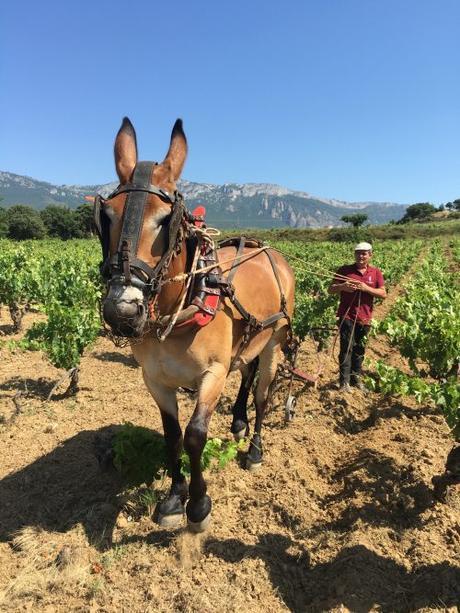
Back in time; mules still plow the vineyards at Bodega Gil Berzal in Rioja Alavesa.
" data-orig-size="500,667" title="Mules at Bodega Gil Berzal." data-image-title="Mules at Bodega Gil Berzal." data-orig-file="https://binnotes.files.wordpress.com/2017/05/img_6771-e1494201661258.jpg" style="width: 696px; height: 928px;" itemprop="http://schema.org/image" height="928" width="696" data-medium-file="https://binnotes.files.wordpress.com/2017/05/img_6771-e1494201661258.jpg?w=225" data-original-height="928" alt="Back in time; mules still plow the vineyards at Bodega Gil Berzal in Rioja Alavesa | Image: ©Michelle Williams" data-original-width="696" data-image-meta="{"aperture":"2.2","credit":"","camera":"iPhone 6s","caption":"","created_timestamp":"1468064278","copyright":"","focal_length":"4.15","iso":"25","shutter_speed":"0.0010141987829615","title":"","orientation":"1"}" data-large-file="https://binnotes.files.wordpress.com/2017/05/img_6771-e1494201661258.jpg?w=500" /> Back in time; mules still plow the vineyards at Bodega Gil Berzal in Rioja Alavesa | Image: ©Michelle WilliamsRioja Alavesa is located in northeastern Spain, west of the Logroño, on the north bank of the Ebro River. It is one of the seven comarcas [demarcated regions] within the Spanish province Alava, with its capital located in Laguardia. Pablo Simón describes his home in an email, “Rioja Alavesa… is a hilly region going from the River Ebro up to the hills of Sierra de Cantabria. And so different profile of soils are into it, some better than others. But in general I would say that this area of Rioja Alavesa, together with some adjacent soils of Rioja Alta, are excellent for growing grapes, as they are, in general, in the northern and fresher area of Rioja and Ebro valley, in soft slopes of chalky soil (and limestone and clay) going down from the mountains to the river, oriented to the South, a bit higher in altitude (+/- between 450-625 meters) than the average of Rioja and with similar fresh Atlantic temperature, normally. Together with other positive element of Rioja Alavesa is that, although there are also a few big owners and producers, in general there are a lot of small wine growers and small-medium producers, with a family hand/homemade philosophy that try to show properly the genuine identity of the soil, climate and grapes of the area.”
ABRA has filed a proposal requesting the formation of a new “Denominación de Origen,” seeking for label information to include such [items] as terroir, lot and winemaking process, along with the words “Euskadi-País Vasco.” The Consejo responded by stating, “We learned about this initiative because of the media. This fact has been really shocking in our institution and we consider it a disloyalty. Not only they should have inform the Consejo before filing the initiative, but this action betrays the DO basic working principles.”
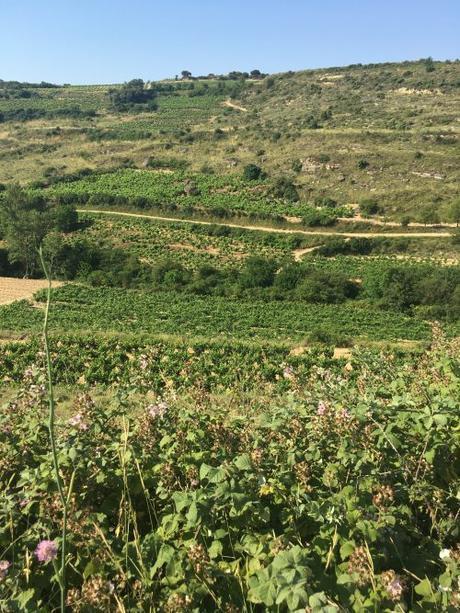
Typical topography of Rioja Alavesa.
" data-orig-size="500,667" title="Rioja Alavesa topography." data-image-title="Rioja Alavesa topography." data-orig-file="https://binnotes.files.wordpress.com/2017/05/img_6737-e1494201544243.jpg" style="width: 696px; height: 928px;" itemprop="http://schema.org/image" height="928" width="696" data-medium-file="https://binnotes.files.wordpress.com/2017/05/img_6737-e1494201544243.jpg?w=225" data-original-height="928" alt="Typical topography of Rioja Alavesa| ©Michelle Williams - Rockin Red Blog." data-original-width="696" data-image-meta="{"aperture":"2.2","credit":"","camera":"iPhone 6s","caption":"","created_timestamp":"1468059805","copyright":"","focal_length":"4.15","iso":"25","shutter_speed":"0.00092336103416436","title":"","orientation":"1"}" data-large-file="https://binnotes.files.wordpress.com/2017/05/img_6737-e1494201544243.jpg?w=500" /> Typical topography of Rioja Alavesa| ©Michelle Williams – Rockin Red Blog.Can you imagine if every wine produced in Bordeaux, Burgundy, or Napa Valley only contained those words? No indication of Saint-Emilion, Margaux, Puligny-Montrachet, Howell Mountain, or Carneros? La Rioja is a vast wine region, yet within it are smaller, distinct regions such as Rioja Alavesa. Why would Rioja oppose allowing its wines and its loyal consumers a greater sense of the place of the wine? The answer is that Rioja wines are crafted from grapes sourced through the region and blended together. Rioja chooses to classify its wines based on how long they are aged in oak – joven, crianza, reserve, gran reserve, rather than with vineyards or villages on the labels. Because most Rioja wines are a blend across the region in an effort to achieve a homogenous, easily recognizable wine, singling out the three sub-regions on the label would be detrimental to some regions that use largely bulk juice, while at the same time benefitting Rioja Alavesa, which produces hand crafted wines with minimal intervention with intentional expressions of terroir. Consumers of Rioja understand this well. It is trial and error to find high quality Rioja wines. Of course they exist, but without knowing anything about the wine from the label other than how long it was aged in oak, it requires much time and money to sort through the massive region to find the quality juice. Consejo’s objective to offer the consumer a homogenous wine representing the entire region has ultimately created an utter lack of consistency.
However, ABRA’s desire to create a new DO is met with mixed reactions. There is hope within the Rioja Alavesa wine making community that the issue can be solved without leaving Rioja, that a compromise can be found. Other wineries, 41 to be exact, believe they are not being heard; therefore, leaving to form a new DO is their only option.
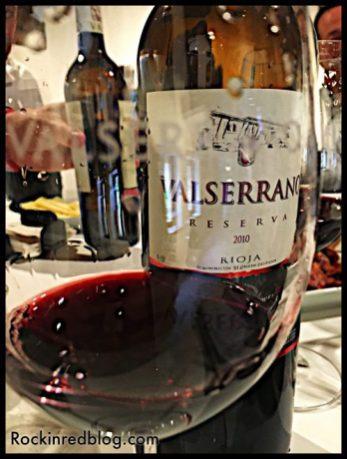
Bodegas De La Marquesa Valserrano produces many lovely wines, among them is this high quality 2010 Reserva, crafted of 90% Tempranillo and 10% Graciano.
" data-orig-size="500,661" title="Bodegas De La Marquesa Valserrano wine." data-image-title="Bodegas De La Marquesa Valserrano wine." data-orig-file="https://binnotes.files.wordpress.com/2017/05/img_7019-e1494201635579.jpg" style="width: 348px; height: 459px;" itemprop="http://schema.org/image" height="459" width="348" data-medium-file="https://binnotes.files.wordpress.com/2017/05/img_7019-e1494201635579.jpg?w=227" data-original-height="459" alt="Bodegas De La Marquesa Valserrano produces many lovely wines, among them is this high quality 2010 Reserva, crafted of 90% Tempranillo and 10% Graciano. | Image: ©Michelle Williams - Rockin Red Blog." data-original-width="348" data-image-meta="{"aperture":"2.2","credit":"","camera":"iPhone 6s","caption":"","created_timestamp":"1467896568","copyright":"","focal_length":"4.15","iso":"200","shutter_speed":"0.04","title":"","orientation":"1"}" data-large-file="https://binnotes.files.wordpress.com/2017/05/img_7019-e1494201635579.jpg?w=500" /> Bodegas De La Marquesa Valserrano produces many lovely wines, among them is this high quality 2010 Reserva, crafted of 90% Tempranillo and 10% Graciano. | Image: ©Michelle Williams – Rockin Red Blog.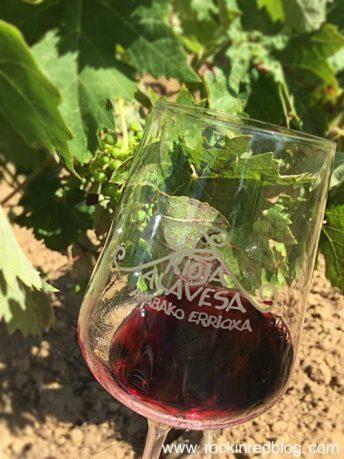
Pablo Simón of Valserrano offers one perspective, “We understand and agree [with] the underlying arguments [of ABRA], but consider that can be promoted without leaving the Denomination of Origin. We are part of Rioja DO and have helped humbly to build it since more than a hundred years ago, and so we feel part of Rioja. The problem, in which we agree with ABRA, is that Rioja is becoming bigger and bigger, and is represented mainly for the big groups, that have different interests to ours (or ways of achieving them), what affects the quality and identity of the wines, together to the prices, margins, etc. But we feel part of the club and want to follow in it, although we want to be better represented in it and some things to change. But from inside.”
Bodega Gil Berzal offers a different perspective, “We are enthusiastic about having the opportunity to have another option out of D.O. Rioja, which allows us to work in a more similar way to our philosophy. According to it, the vineyards, the soil, the respect for the environment and people, as well as to generate value trigger not just the production of quality wines, also wines which are able to touch. In addition, Rioja follows a general direction towards overproduction, without giving value to the product and to all that surrounds it. Thus, it forgets the old vineyard, the ‘terroir’, the scenery and the soils, and it gives importance just to the price, which includes every type of practices in the same boat. [Furthermore,] Rioja has forgotten its roots and it gives the prominence to the barrel, basing its attributes in the presence of the wine in touch with the wood. It does not even consider the type of wood or barrels which are used. Our area is different from the rest of areas included in the D.O. Rioja, due to the characteristics of the soils, climate, age of the vineyards, and the relief of the land. This is the reason to give Rioja Alavesa its worth. Finally, the province of Alava has been historically and culturally settled in the world of the wine, being the only cultivation widespread in the region of Rioja Alavesa. At the same time, the growing of the vine has been the only sustenance and way of living of its people.”
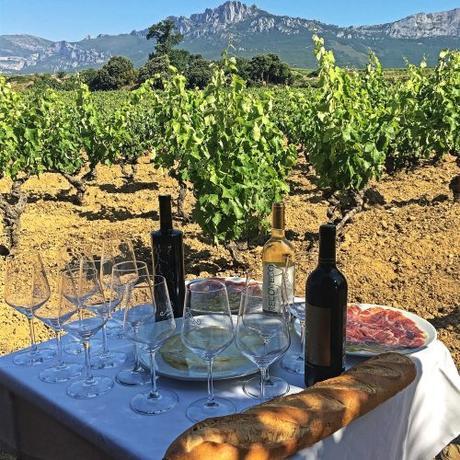
Breakfast in the vineyards at Bodega Gil Berzal.
" data-orig-size="500,500" title="Breakfast Bodega Gil Berzal." data-image-title="Breakfast Bodega Gil Berzal." data-orig-file="https://binnotes.files.wordpress.com/2017/05/img_6777-e1494201707550.jpg" style="width: 696px; height: 696px;" itemprop="http://schema.org/image" height="696" width="696" data-medium-file="https://binnotes.files.wordpress.com/2017/05/img_6777-e1494201707550.jpg?w=300" data-original-height="696" alt="Breakfast in the vineyards at Bodega Gil Berzal. | ©Michelle Williams - Rockin Red Blog." data-original-width="696" data-image-meta="{"aperture":"0","credit":"","camera":"","caption":"","created_timestamp":"0","copyright":"","focal_length":"0","iso":"0","shutter_speed":"0","title":"","orientation":"1"}" data-large-file="https://binnotes.files.wordpress.com/2017/05/img_6777-e1494201707550.jpg?w=500" /> Breakfast in the vineyards at Bodega Gil Berzal. | ©Michelle Williams – Rockin Red Blog.Though a split may happen, it is unsure how it will impact both regions. Wine industry insiders outside the region acknowledge the differences in the sub-regions soil and production techniques, but believe it is unclear how a split will impact the future sales of Rioja Alavesa since many consumers only know it as Rioja. According to Paco Berciano, writer, journalist and winemaker, “establishing a new DO is not the best solution because this one will be small and the differences are not so marked to launch a competitive product against Rioja DO.” Joan C. Martín, oenologist and writer ofthe “Los Supervinos” guides, agrees Rioja Alavesa’s product “is more special and puts value in local and small productions versus big productions;” however, she recognizes “it will be difficult for the wineries because they will have to say goodbye to Rioja name, which is the reason why they are selling.” However, Ines Baigorri, director of ABRA states, “We expect the project to thrive because we have worked on it for a long time in the legal aspect and in the proposal. In Europe there are thousands of DO and a lot of them coming, this is a reason why we are hopeful”.
There are rumors swirling that Consejo is discussing allowing changes in the Rioja labeling laws. Will it be enough to appease ABRA and the 41 wineries who seek to form a new DO? Ines Baigorri said ABRA is moving forward with the formation of a new DO despite possible concessions from Consejo. Will all 41 wineries stay onboard if they get what they want from Consejo? Only time will tell.
About the Author:
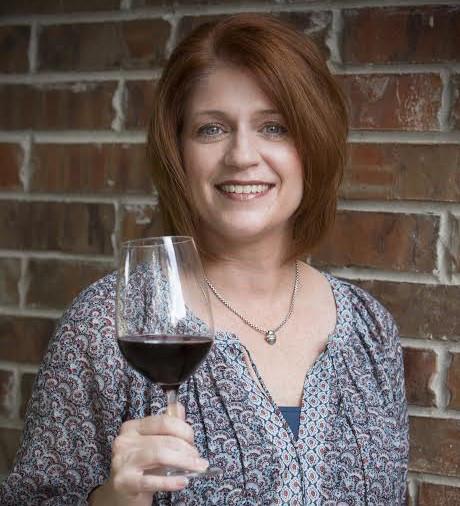
Michelle Williams is author of the award-winning Rockin Red Blog, and a contributor to Snooth.com.
" data-orig-size="460,506" sizes="(max-width: 460px) 100vw, 460px" data-image-title="Michelle Williams" data-orig-file="https://binnotes.files.wordpress.com/2017/05/michelle-williams2.jpg?w=700" data-image-meta="{"aperture":"0","credit":"","camera":"","caption":"","created_timestamp":"1472573462","copyright":"","focal_length":"0","iso":"0","shutter_speed":"0","title":"","orientation":"1"}" data-medium-file="https://binnotes.files.wordpress.com/2017/05/michelle-williams2.jpg?w=700?w=273" data-permalink="https://binnotes.com/2017/05/26/guest-wine-writer-series-%e2%84%96-13-michelle-williams-rioja-alavesa-es/michelle-williams2/" alt="" srcset="https://binnotes.files.wordpress.com/2017/05/michelle-williams2.jpg 460w, https://binnotes.files.wordpress.com/2017/05/michelle-williams2.jpg?w=136 136w, https://binnotes.files.wordpress.com/2017/05/michelle-williams2.jpg?w=273 273w" class="size-full wp-image-16730" data-large-file="https://binnotes.files.wordpress.com/2017/05/michelle-williams2.jpg?w=700?w=460" />Michelle Williams writes freelance about wine, food, and travel for Snooth and on her award-winning blog Rockin Red Blog. She is one of the Top 100 Most Influential Wine Bloggers. Michelle resides with her family in the Dallas area and has an affinity for pairing wine with music. She holds a master’s degree in History of the Christian Tradition and enjoys discovering the links between wine and religious history. Michelle’s passion for wine is equaled by her passion for knowledge; therefore, she embraces global travel to experience wine regions first hand.
Story and images printed by permission of the author, Michelle Williams
❦
For more on previous 2017 Guest Writer Contributions:
Susannah Gold | Falling in Love with the Douro
Caroline Henry | The Real Meaning of Terroir in Champagne Today
Copyrighted 2017 binNotes | redThread™. All Rights Reserved.

